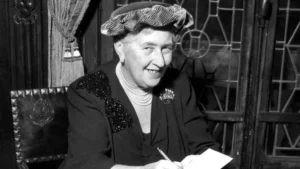NIN365 Desk, Kolkata : In the grand tapestry of crime fiction, Agatha Christie stands as the “queen of crime,” weaving captivating tales that have enthralled readers for decades. Her inaugural novel, “The Mysterious Affair at Styles,” not only introduced the world to the brilliant detective Hercule Poirot but also drew inspiration from a real-life murder mystery that unfolded in the serene hills of Mussoorie, India.
The Birth of a Classic: The Mysterious Affair at Styles
Published in 1920, “The Mysterious Affair at Styles” immerses readers in a suspenseful whodunnit centered around the murder of wealthy Emily Inglethorp. Suspicion shrouds her second husband, 20 years her junior, captivating the entire Inglethorp clan, including her confidante Evelyn Howard. The narrative unfolds with multiple suspects, shocking twists, and a climactic reveal that has become synonymous with Christie’s signature style.

However, what makes this novel truly intriguing is its alleged connection to a sensational murder that gripped Mussoorie over a century ago. In September 1911, Frances Garnett Orme was discovered lifeless in her room at the opulent Savoy hotel. The post-mortem report revealed a grim reality—she had been poisoned with prussic acid, a cyanide-based toxin. The accused, Eva Mount Stephens, Orme’s friend and spiritual companion, faced the daunting charge of murder.
Mussoorie’s Enigmatic Murder: Reality and Inspiration
Frances Orme, a lonely woman immersed in occult practices, befriended Eva Stephens, a spiritualist from Lucknow. The two resided together at the Savoy, where Stephens claimed to have cared for the ailing Orme. However, the prosecution alleged a sinister motive—Stephens supposedly poisoned Orme to benefit from her substantial inheritance. The defense countered, proposing that Orme’s demise was a consequence of unceasing grief and deteriorating health.
The case perplexed investigators with its twists and turns. Stephens had left for Lucknow before Orme’s death, and the locked room added an air of mystery. The absence of incriminating evidence, save for a bottle of sleeping pills and ambiguous labels, further complicated the trial. The prosecution’s claim that Stephens had predicted Orme’s death months in advance and voiced concerns about her marrying a physician added another layer of complexity.
In a surprising turn, Stephens was acquitted, leaving the judge to remark on the elusive truth behind Orme’s demise. Indian author Ruskin Bond drew parallels between this captivating case and Agatha Christie’s debut novel, asserting that Christie had drawn inspiration from the sensational Mussoorie murder.
Christie’s Narrative Echo: The Intriguing Parallels
“The Mysterious Affair at Styles” mirrors the Mussoorie murder in startling ways. Emily Inglethorp, like Frances Orme, meets her end through poisoning, and the locked room scenario is replicated. The revelation at the story’s climax implicates Evelyn, Emily’s companion, who cunningly procures the poison with a forged signature, motivated by financial gain.
Decades later, the connection between these cases continues to captivate enthusiasts. At the International Agatha Christie Festival in 2022, crime writer Manjiri Prabhu highlighted the intriguing link between Christie’s narrative and the Mussoorie murder. The resonance between reality and fiction underscores the enduring allure of true crime woven into the fabric of classic mysteries.
* Beyond Christie: Poisonous Tales of Passion in Colonial India
Christie wasn’t the sole author inspired by poison-laden tales from colonial India. Cecil Walsh’s “The Agra Double Murder” unravels a crime of passion in Agra, then under the United Provinces of Agra and Oudh. Augusta Fullam and Dr. Clark conspired to poison their spouses, echoing the themes of love, betrayal, and toxicity that reverberated through the Raj.
In the 19th century, poisoning cases were not uncommon in India, reflecting a broader global trend. The sale of toxic substances, particularly arsenic, was unregulated. David Arnold, in “Toxic Histories,” delves into how arsenic poisonings prompted the framing of the Indian Poisons Act in 1904, aiming to regulate the sale and use of deadly substances. Notorious cases, including the Orme murder and the Fullam-Clark affair, played a pivotal role in shaping poison control legislation.
* True Crime’s Enduring Allure: A Glimpse into History
As true crime captivates audiences through various mediums—films, podcasts, and web shows—Agatha Christie’s “The Mysterious Affair at Styles” remains a timeless gem within this grisly canon. The convergence of reality and fiction, with echoes of colonial-era scandals and mysteries, adds a layer of depth to Christie’s legacy.
In a world where the line between truth and imagination blurs, these tales of intrigue and deception continue to resonate. The legacy of Agatha Christie endures, not just as the “queen of crime,” but as a masterful storyteller who wove narratives that transcended time and drew inspiration from the enigmatic pages of history.
DISCLAIMER
Our news media denounces any form of bias and disapproves of sensationalism. The disseminated news is entirely educational and aimed at social awareness. Our media maintains absolute impartiality, adhering solely to the purpose of education and social consciousness.